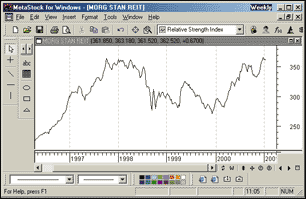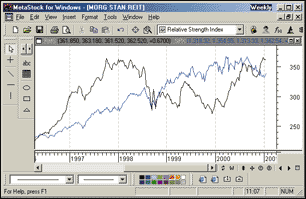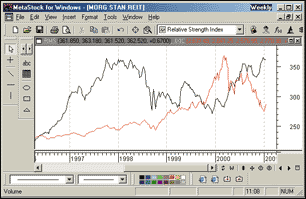
HOT TOPICS LIST
- Strategies
- Stocks
- Buy
- Investing
- Brokers
- Psychology
- Interviews
- Accumulate
- Sell
- Hold
- Spotlight
- Websites
- Candlestick Corner
- Gold & Metals
- Options Trading
LIST OF TOPICS
INVESTING
Are You Ready For Reits?
03/02/01 09:58:07 AM PSTby David Penn
Could putting your money in real estate investment trusts meet your long-term investment needs?
| Once upon a time, not so long ago, the way to make money in the United States was in real estate. In fact, for a brief, shining moment in the history of real estate, it seemed as if all someone had to do was to buy a house, then sell it and use the proceeds to buy a bigger house. Repeat as necessary until it was time for the Sun Valley retirement community -- paid for by, you guessed it, the proceeds from your last house sale. For better or worse, those days are gone. The real estate boom of yesteryear -- largely fueled by high baby boomer demand and relatively low housing supply -- crashed as supply eventually caught up with demand and those looking for a quick buck in the real estate market took their profits and ran. In fact, for much of the 1990s, particularly as the stock market embarked upon its historic bull advance, investing in real estate was increasingly seen not as a sure path to capital appreciation, but as a speculative venture for those risk-seekers looking only to hit home runs. This does not mean that investors cannot still make intelligent and profitable investments in real estate. But it does mean that in the absence of experience or specialized knowledge in the field, everyday investors would be better off staying away from the "For Sale" signs and getting closer to real estate investment trusts, or REITs for short. These instruments are essentially baskets of real estate companies, and the best among them are helping investors realize significant gains while diversifying their holdings. WHEREFORE REITS? Real estate investment trusts (REITs) are companies that own and/or manage real estate properties. These properties may be residential, such as apartment buildings, or commercial, such as office complexes, or some blend of the two. While real estate developers take advantage of REITs as a source of capital to fund or to complete funding for building projects, investors seek out REITs for their ability to generate cash through rents and leases. The growth of REITs was limited by laws that restricted them to simply owning real estate properties for many years after the creation of REITs as legal investment trusts in 1960. The Tax Reform Act of 1986 revolutionized the REITs industry by allowing the trusts to manage as well as own real estate properties. This event was a watershed for REITs, making them competitive tools for capital appreciation for average, everyday investors. But the biggest windfall for REITs may have just occurred. As of 2001, the REIT Modernization Act will enable REITs to create taxable REIT subsidiaries (TRS) that will add significant value to REITs as well as help REITs compete with privately owned real estate properties. For example, a REIT owning a number of office buildings can now, through the Modernization Act, create a taxable subsidiary that does office cleaning or landscaping for the properties. In the past, REITs were forbidden by law to do anything more than own and manage real estate properties, a rule that put the publicly owned REIT at a disadvantage to private real estate companies. The Act, which passed with strong bipartisan support, also lowers the required minimum dividend payout percentage from 95% to 90%, which will help REITs looking to raise capital and decrease leverage as well as keep REIT dividend payout levels comparable with similar requirements for mutual funds, after which REITs were initially modeled. Most REIT shares are traded on the major stock exchanges, and thus can be tracked and evaluated like individual stocks or closed-end funds. A popular benchmark for REITs is the Wilshire REIT index, which consists of over 100 trusts. There are essentially three different types of real estate investment trusts: equity REITs, mortgage REITs, and hybrids -- though the vast majority of REITs are equity REITs. Equity REITs, which make up about 96% of all real estate investment trusts, invest in and own real estate properties and make most of their money from rents paid on these properties. Mortgage REITs handle the investment and ownership of property mortgage loans by lending money to property owners, or by investing in existing mortgages or mortgage-backed securities. As you might imagine, the revenues for mortgage REITs come from interest paid on the loans. Hybrid REITs invest in both real property as well as mortgages. In addition, there are REIT subtypes, REITs that, for example, specialize or focus on certain geographic regions or property types -- even REITs that only own golf courses or prisons! RATING REITS The growth of real estate investment trusts over the past decade has been nothing short of amazing. The number of REITs almost doubled from 100 to just short of 200 in the 1990s, and the market capitalization for real estate investment trusts swelled from less than $9 billion to $139 billion over the same period. While REIT performance has been between that of bonds and equities over the last 10 years -- varying between 10% to 15% historically -- many investors still see REITs more as defensive investments than as core constituents of a balanced, well-diversified portfolio. When selecting among REITs for quality investments, there are a couple of things to look for. Perhaps foremost is a strong management team. With REITs allowed to actually manage real estate properties instead of just owning them, there is a significant premium on a strong management team capable of garnering sufficient debt or capital for improvements and/or expansion. Like investing in mutual funds, it can be worthwhile to check a REIT's performance against the tenure of its current management team. A REIT that has outperformed its peers, yet has a recent major change in management, may not be the same REIT it was while it was racking up those strong returns. Another significant factor is the REITs' funds from operations (FFO). Generally speaking, net income figures assume a gradual depreciation in asset value over time. With real estate investment trusts, however, the value of the underlying assets -- real estate -- can actually increase over a period. To reflect this aspect of REIT performance, FFO excludes what is referred to as "historic depreciation" from the final net income tally. Other ways this net income may be referred to include CAD, as in "cash available for distribution," FAD, or "funds available for distribution," or AFFO, "adjusted funds from operations." REIT REWARDS One of the largest benefits of investing in REITs is the fact that they are required by law to distribute a minimum of 95% of their taxable income to shareholders. This means that the more successful REITs can become virtual cash-flow machines for their investors, investors who will reap the maximum benefits from REITs' revenue growth. Compared to investments like mutual funds, in which a money manager may store large amounts of capital in lower-returning cash instruments from time to time, REITs, by law, are always pushing the cash-flow envelope, trying to secure longer-term leases from tenants at the most profitable rates. In addition, REITs often pay sizable dividends; in fact, the average dividend yield on REITs in 2000 was 8%, far more than the average dividend paid out by the small-cap stocks of the Russell 2000 (REITs are 6% of the Russell 2000 small-cap index). This significant dividend yield, by the way, is one of the reasons many investors flocked to REITs in 2000, when both the Nasdaq and the Standard & Poor's 500 index were mired in downturns. Not only that, the value of REITs has historically had a low correlation to the value of other assets, further underscoring the occasional "safe haven" character of REIT investing. Safe havens or not, real estate investment trusts have not always been popular places for investors to grow their money. Over the past three years, REITs -- as measured by Morgan Stanley's REIT index -- have underperformed both the S&P 500 and the Russell 2000 index of small-cap stocks (of which, again, REITs represent 6%). (See Figures 1-4.) As measured by Morgan Stanley's REIT index, real estate investment trusts kept up with the major market averages until the summer of 1999, when both the S&P and Russell 2000 rallied and the REIT index moved down toward year-to-date lows. However, the busts of 2000 -- the steep market downturns in March/April and September/October -- turned into booms for REITs as the real estate investment trust index gained more than 20% by the end of the year.
Jay Hyde, senior director of communications and a spokesperson for the National Association of Real Estate Investment Trusts (NAREIT), helps put some of these returns in context. Noting that REITs really came of age in the last decade, Hyde points to composite REIT performances of 18% in 1995, 35% in 1996, and 19% in 1997. "REITs were the darlings of Wall Street," he explains, adding that there were "headlines and cover stories [in] major business and investing publications -- %91Stocks, Bonds, and REITs' -- in other words" equating REITs with other financial instruments of far greater familiarity. The problem was that, in some ways, REITs became victims of their own success. As REIT performance soared in the mid-1990s, many momentum-style investors began treating REITs as though they were growth stocks instead of the income-oriented investments they were designed as. When REIT returns lagged in 1998 -- in part due to the general market downturn and the Russian debt crisis -- much of that momentum money fled, dragging REIT returns down. The REIT composite was down 19% in 1998 and another 6% in 1999. Despite that performance, "the fundamentals of REITs hadn't changed," Hyde points out. Analysts following the REIT industry were still bullish and, in fact, by 1999 began suggesting strongly that REITs were oversold. All the same, investors by 1999 had become enamored of technology stocks, almost to the exclusion of all other investments. Never mind, as Hyde recalls, that REIT analysts were "shouting from the rooftops that the love affair with tech stocks wouldn't go on forever." It took the catastrophic Nasdaq meltdown in the spring of 2000 to finally get investors to appreciate the benefits of a diversified portfolio again. "Maybe there's something to be said for investments that aren't as volatile as the Nasdaq," Hyde mused. "Or even the Dow Jones." And truly, the combination of less volatility and high dividend yields ended up being a winner in 2000. When it comes to incorporating REITs in a diversified portfolio, Hyde notes that institutional investors often have between 5% and 10% of their holdings in real estate, though many of these real estate holdings are in direct ownership of real estate properties. What is important, he says, is that investors remained focused on the big picture of what a well-diversified portfolio can do. MORE ON REITS There are a number of excellent online sources for more information about real estate investment trusts. Perhaps at the top of this list, however, is the website of the National Association of Real Estate Investment Trusts (NAREIT) at www.nareit.com. NAREIT is a trade association for real estate investment trusts that started in 1960, and has since represented both REITs and those professionals who provide services to them. NAREIT also provides a wealth of educational and statistical information about the real estate investment trust industry for both individual and institutional investors. David Penn can be reached at DPenn@Traders.com. |
Technical Writer for Technical Analysis of STOCKS & COMMODITIES magazine, Working-Money.com, and Traders.com Advantage.
| Title: | Traders.com Technical Writer |
| Company: | Technical Analysis, Inc. |
| Address: | 4757 California Avenue SW |
| Seattle, WA 98116 | |
| Phone # for sales: | 206 938 0570 |
| Fax: | 206 938 1307 |
| Website: | www.traders.com |
| E-mail address: | DPenn@traders.com |
Traders' Resource Links | |
| Charting the Stock Market: The Wyckoff Method -- Books | |
| Working-Money.com -- Online Trading Services | |
| Traders.com Advantage -- Online Trading Services | |
| Technical Analysis of Stocks & Commodities -- Publications and Newsletters | |
| Working Money, at Working-Money.com -- Publications and Newsletters | |
| Traders.com Advantage -- Publications and Newsletters | |
| Professional Traders Starter Kit -- Software | |
PRINT THIS ARTICLE

|

Request Information From Our Sponsors
- StockCharts.com, Inc.
- Candle Patterns
- Candlestick Charting Explained
- Intermarket Technical Analysis
- John Murphy on Chart Analysis
- John Murphy's Chart Pattern Recognition
- John Murphy's Market Message
- MurphyExplainsMarketAnalysis-Intermarket Analysis
- MurphyExplainsMarketAnalysis-Visual Analysis
- StockCharts.com
- Technical Analysis of the Financial Markets
- The Visual Investor
- VectorVest, Inc.
- Executive Premier Workshop
- One-Day Options Course
- OptionsPro
- Retirement Income Workshop
- Sure-Fire Trading Systems (VectorVest, Inc.)
- Trading as a Business Workshop
- VectorVest 7 EOD
- VectorVest 7 RealTime/IntraDay
- VectorVest AutoTester
- VectorVest Educational Services
- VectorVest OnLine
- VectorVest Options Analyzer
- VectorVest ProGraphics v6.0
- VectorVest ProTrader 7
- VectorVest RealTime Derby Tool
- VectorVest Simulator
- VectorVest Variator
- VectorVest Watchdog




